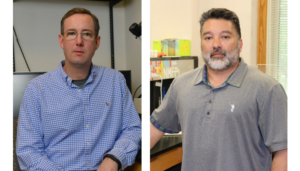 A collaboration between Dr. Chris Lorson and Dr. Michael Garcia of the University of Missouri and funded by the CMT Research Foundation is producing promising results in an innovative new approach to treating CMT2E.
A collaboration between Dr. Chris Lorson and Dr. Michael Garcia of the University of Missouri and funded by the CMT Research Foundation is producing promising results in an innovative new approach to treating CMT2E.
CMT2E presents a special challenge in that the mutated gene, NEFL, cannot simply be removed or silenced – the gene is essential for nerve function and cell heath. In order to prevent or reverse symptoms in people with CMT2E, researchers must develop a way to silence the mutated version of the gene while introducing a healthy copy. This approach is called “knockdown and replace”.
In the first stage of the project, Drs. Lorson and Garcia tested the ability of multiple different therapeutics to reduce the gene expression of NEFL. The best performing therapeutic was then utilized in the second phase of the project.
Often, the most difficult aspect of developing a new gene therapy is delivering the therapy to the correct cells in the body. This is of particular concern in CMT due to the presence of the blood-nerve barrier. This barrier protects the peripheral nerve cells from toxins that may be in the bloodstream, but it also prevents many drugs from reaching these cells – which is why overcoming the blood-nerve barrier is a primary focus for the CMT Research Foundation. In the second stage of the project, the team at the University of Missouri designed a gene delivery vehicle called a vector to carry the best genetic therapeutic they identified in stage one. They also included a healthy copy of the NEFL in this genetic vector that would be able to both silence the mutated gene and introduce a healthy copy into affected cells.
In the third and final stage of the project, Drs. Lorson and Garcia will inject the new vector into mice with CMT2E and evaluate response to the therapy. For this the team created a new mouse model of CMT2E where the mice develop symptoms at a much younger age and their symptoms are more severe, which creates a larger window of opportunity to observe how well the therapeutic is able to prevent and/or reverse symptoms.
If successful, this “knockdown and replace” method could work for any CMT-causing mutations that require a reduction in mutated protein and an increase in healthy protein.
Project Announcement: https://cmtrf.org/new-study-precision-medicine-for-cmt/
Milestone 1 Complete: https://cmtrf.org/research-update-for-cmt2e/
